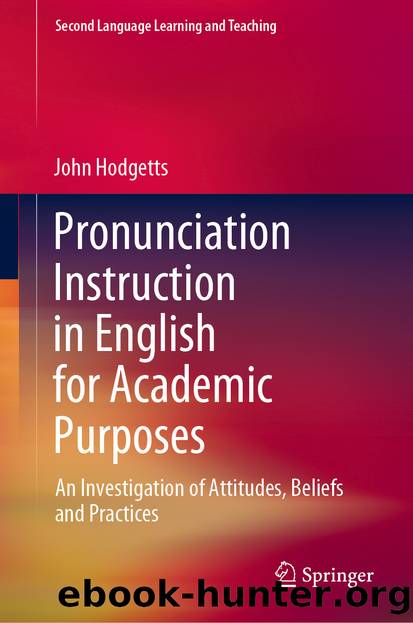Pronunciation Instruction in English for Academic Purposes by John Hodgetts

Author:John Hodgetts
Language: eng
Format: epub
ISBN: 9783030561161
Publisher: Springer International Publishing
4.4.5 Semi-structured Interviews
Rationale
Semi-structured teacher interviews have been used as an important method for uncovering the reasons why some teachers have become reluctant to teach pronunciation, and have been particularly effective when used in conjunction with other methods as part of a mixed methods approach (Baker, 2011, 2014; Baker & Murphy, 2011, Cohen & Fass, 2001). Macdonald (2002), in an Australia ESL study, showed that teachers who were reluctant to provide instruction cited poor guidance, training policies, and a lack of adequate materials as explanations for this reluctance. These teachers also stated that they employed no systematic instruction and that they only drew attention to pronunciation or made any intervention when intelligibility was threatened. In my own research, I combined general questions relating to teacher beliefs with questions which arose from the observations in order to explore how beliefs and attitudes informed instruction. The interviews enabled a comparison of stated practice and actual practice, and facilitated an in-depth exploration of the specific challenges of providing instruction on a ten-week EAP pre-sessional course. They also yielded some possible solutions to stated problems. Phipps and Borg (2007) used classroom observation and semi-structured interviews in order to compare teacher beliefs with actual instruction. Although there was no specific focus on pronunciation instruction, the study showed that teacher trainees (on a DELTA course) did experience difficulty in translating their stated beliefs into classroom instruction. The combination of observation and semi-structured interviews in my own research (Hodgetts, 2014) was also useful in examining the connections between stated beliefs and practice. Like Cohen and Fass (2001), in my own research, certain discrepancies between teacher perceptions of their own practice and actual practice were uncovered.
Implementation
The CL interview was semi-structured in nature in order to afford flexibility and the freedom to explore particular areas in depth (the CL interview guide can be found in Appendix F). The major issues addressed are as follows: institutional goals and the target of instruction (e.g., segmental vs. suprasegmental instruction/native speaker production as the target vs. intelligibility), whether teachers are aware of these goals and the target of instruction, error correction (to enable a comparison with the observation/checklist data), listening materials and other pronunciation materials, the CL's viewpoint on the difficulties teachers face, how well staff training/induction prepares the staff in providing instruction, how instruction has evolved, and the frequency of instruction. The set of 12 principal questions was augmented by seven further questions that I added as a result of observations that I had made during the course. For example, the CPD session stressed the importance of learners giving academic presentations because this is something that the vast majority of learners have to do on their future courses. I was therefore interested in why the assessment of the presentation strand of the pre-sessional course was only formative rather than summative in nature. I was also able to address the advice given by the CL during induction regarding the erroneous production of the dental fricative (i.e., that it was an error that was easily remedied).
Download
This site does not store any files on its server. We only index and link to content provided by other sites. Please contact the content providers to delete copyright contents if any and email us, we'll remove relevant links or contents immediately.
Side by Side by Charles Sophy(804)
World Philology by(678)
The Quick And Easy Way To Effective Speaking by Dale Carnegie(656)
Everyday English: 556 collocations with pictures. Learn English vocabulary and expressions to speak about social situations. by Deniskina Julia(499)
Cambridge IGCSE and O Level Business Studies by Karen Borrington(417)
Speed Reading: How to Read a Book a Day - Simple Tricks to Explode Your Reading Speed and Comprehension (Accelerated Learning Series 2) by Ryan James(370)
IELTS Vocabulary Writing Task 2 Band 8 2021 : Topic-Wise Vocabulary for IELTS Writing Task 2 with Most Probable Questions by Suyash Kanchan(363)
English Vocabulary for Beginning ESL Learners by Jean Yates(353)
The Ultimate ESL Vocabulary Manual (The Ultimate ESL Teaching Manual Book 4) by Jones Andromeda(342)
The Jungle Book Level 2 Oxford Bookworms Library by Rudyard Kipling(332)
English Pronunciation Teaching and Research by Martha C. Pennington & Pamela Rogerson-Revell(311)
IELTS Topic-Wise Writing Band 8 Vocabulary 2021 : Masterbook for all band 8 vocabulary by Kanchan Suyash(307)
IELTS ACADEMIC TASK 1 - MOST PROBABLE QUESTIONS & Suggested Answers: MAY - AUGUST 2021 by Kanchan SUYASH(300)
Language Acquisition by Maria Teresa Guasti(298)
Speaking English as a Second Language by Unknown(293)
IELTS ACADEMIC TASK 1 - MOST PROBABLE QUESTIONS & Suggested Answers: MAY - AUGUST 2021 by AUGUST 2021(288)
Perfect Phrases for ESL Everyday Situations by Natalie Gast(281)
IELTS General Writing Task 1 Most Probable Questions: May - August 2021 by Kanchan Suyash(277)
Italian: The Italian Language Learning Guide for Beginners by Macario Liuzzo(276)
